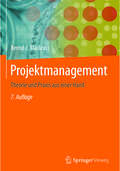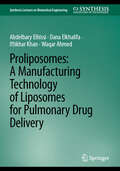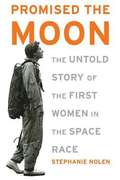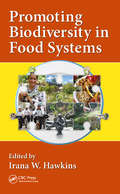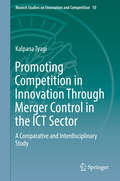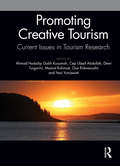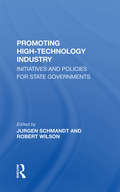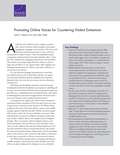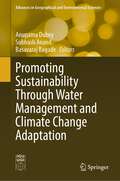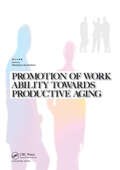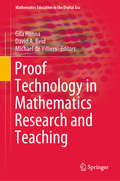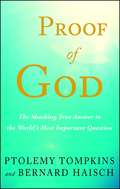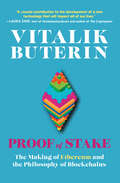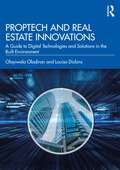- Table View
- List View
Projektmanagement: Theorie und Praxis aus einer Hand
by Bernd-J MadaussIn der siebten Neuauflage dieses Fachbuchs werden alle wesentlichen Aspekte des Projektmanagements in Theorie und Praxis umfassend behandelt. F#65533;r Beh#65533;rden und Unternehmen die mit der Abwicklung nationaler und internationaler Projektaufgaben befasst sind, ist der Einsatz eines professionellen Projektmanagements eine zwingende Voraussetzung um den globalen Wettbewerb erfolgreich zu bestehen. In diesem Buch werden die Teilprozesse des Projektmanagements beschrieben und durch Praxisbeispiele erg#65533;nzt. Kernthemen sind: die Bedeutung des Projektmanagements f#65533;r Industrie und Beh#65533;rden, Projektpannen und ihre Behebung, Zieldefinition und Lebenszyklus, Organisationskonzepte, Systemf#65533;hrung und Qualit#65533;tsmanagement im Projekt, Strukturierungsmethoden, Planung und #65533;berwachung, Kostenermittlung, Konfigurations#65533;berwachung, #65533;nderungsmanagement, Informationsmanagement, Projektpersonal, Risikomanagement, Softwareeinsatz und internationale Projektarbeit im globalen Umfeld. Modellhaft wird ein Fortbildungskurs f#65533;r das Projektmanagement skizziert.
Projektmanagement: Theorie und Praxis aus einer Hand
by Bernd-J. MadaussIn diesem Fachbuch werden alle wesentlichen Aspekte des Projektmanagements in Theorie und Praxis umfassend behandelt. Für Behörden und Unternehmen, die mit der Abwicklung nationaler und internationaler Projektaufgaben befasst sind, ist die Anwendung von professionellen Projektmanagementmethoden eine zwingende Voraussetzung, um den globalen Wettbewerb erfolgreich bestehen zu können. In diesem Buch werden die Prozesse des Projektmanagements detailliert beschrieben und durch Praxisbeispiele ergänzt. Kernthemen sind: die Bedeutung des Projektmanagements für Industrie und Behörden, Projektpannen und ihre Behebung, Zieldefinition und Lebenszyklus, Organisationskonzepte, Systemführung und Qualitätsmanagement im Projekt, Strukturierungsmethoden, Planung und Überwachung, Kostenermittlung, Konfigurationsüberwachung, Änderungsmanagement, Informationsmanagement, Projektpersonal, Risikomanagement, Softwareeinsatz und die an Bedeutung zunehmend internationale Projektarbeit im globalen Umfeld. Modellhaft werden die Struktur eines Fortbildungskurses zum Thema Projektmanagement und ein Trainingskonzept in englischer Sprache beschrieben. Das letzte Kapitel enthält eine kritische Bestandsaufnahme der vorhandenen Methoden und deren Anwendung, gefolgt von einer Skizzierung der Zukunftsaussichten zur effizienteren Projektabwicklung.
Projektverträge im Anlagenbau und für vergleichbare Investitionsprojekte
by Christoph Schmitt Eberhard KrüglerProjektverträge regeln das Rechtsverhältnis zwischen dem Investor als Auftraggeber und dem Unternehmer als Auftragnehmer. Sie sind bei der Realisierung komplexer Projekte weit verbreitet, vor allem im Anlagenbau, aber auch bei der Beschaffung von Gütern und bei der Softwareentwicklung. In dem Buch werden die wesentlichen Aspekte und Inhalte vor dem Hintergrund der einschlägigen gesetzlichen Regelungen besprochen. Hinweise und Vorschläge zur Vertragsgestaltung berücksichtigen die aktuelle nationale und internationale Unternehmens- und Vertragspraxis.
Prokaryotic Antimicrobial Peptides
by Sylvie Rebuffat Djamel DriderThe book will provide an overview of the advancement of fundamental knowledge and applications of antimicrobial peptides in biomedical, agricultural, veterinary, food, and cosmetic products. Antimicrobial peptides stand as potentially great alternatives to current antibiotics, and most research in this newly-created area has been published in journals and other periodicals. It is the editors' opinion that it is timely to sum up the most important achievements in the field and provide the scientific community in a reference book. The goals of this project include illustrating the achievements made so far, debating the state of the art, and drawing new perspectives.
Proliposomes: A Manufacturing Technology of Liposomes for Pulmonary Drug Delivery (Synthesis Lectures on Biomedical Engineering)
by Waqar Ahmed Abdelbary Elhissi Dana Elkhalifa Iftikhar KhanProliposome technologies are stable phospholipid formulations that provide an approach to generating liposomes upon addition of aqueous phase prior to administration. In this monograph, the authors review the potential of proliposomes for pulmonary delivery of liposomes via nebulization using air-jet, ultrasonic and vibrating-mesh nebulizers. They explore both proliposome types, particulate-based and solvent-based. The book concludes that both types are capable of exploiting the energy of nebulization to generate liposomes within nebulizers.
Prometeo americano: El triunfo y la tragedia de J. Robert Oppenheimer
by Kai Bird Martin J. SherwinPremio Pulitzer 2006 National Book Critics Circle Award 2005 Duff Cooper Prize 2008 La biografía definitiva de Oppenheimer, el padre de la bomba atómica y una de las figuras más emblemáticas del siglo XX. El 16 de julio de 1945, en el desierto de Nuevo México, se detonaba en secreto la primera bomba atómica. Impactado por el poder destructivo de su creación, J. Robert Oppenheimer, director del Proyecto Manhattan, se comprometería desde entonces a luchar contra el desarrollo de la bomba de hidrógeno y contra la guerra nuclear. Sospechoso de comunista para los Estados Unidos de la era McCarthy, fue perseguido por el FBI, calumniado como espía de la Unión Soviética y obligado a dimitir de cualquier función pública. Su vida privada fue arrastrada del mismo modo hacia el esperpento; su casa fue allanada con micrófonos ocultos, y su teléfono, intervenido. No sería hasta 1963 que el presidente Kennedy lo rehabilitaría y, con ello, su figura obtendría otro cariz para los ciudadanos del mundo entero. Treinta años de entrevistas a familiares, amigos y colegas; de búsqueda en archivos del FBI; de análisis de las cintas con discursos e interrogatorios, y de hallazgos de documentos privados del físico nuclear dieron como resultado este monumental libro. Una biografía de una enorme minuciosidad que ofrece una visión íntima del científico más famoso de su generación; una de las figuras icónicas del siglo xx para quien el triunfo y la tragedia se unieron en un nudo gordiano. Críticas:«Se lee como un thriller, cautivador y aterrador por momentos. Sospecho que este año no aparecerá una biografía más absorbente ni, dados los peligros a los que nos enfrentamos, más importante que esta».John Carey, Sunday Times «La biografía definitiva [...] La vida de Oppenheimer no nos influye; nos persigue».Newsweek «Todas las obras anteriores sobre este tema quedan, por decirlo de la manera más amable, despedazadas, frente a este libro que es metafórica y literalmente monumental».Mark Lawson, Esquire «Esta imponente biografía, resultado de veinticinco años de investigación, reevalúa la figura de Oppenheimer, y ofrece uno de los retratos más complejos del físico hasta la fecha».The New Yorker «Un libro esencial».Time «Una obra de voluminosa erudición y lúcida perspicacia que une el retrato del multifacético Oppenheimer con la aguda comprensión de su naturaleza».The New York Times «Un relato magistral del ascenso y la caída de Oppenheimer, situado en el contexto de las turbulentas décadas de la transformación de Estados Unidos. Es un tour de force».Los Angeles Times Book Review «La primera biografía que da cuenta de la extraordinaria complejidad de Oppenheimer. Se erige como un Everest entre las montañas de libros sobre el proyecto de la bomba atómica y Oppenheimer, y es un logro que tal vez no será superado ni igualado».The Boston Globe «Excepcional y documentada con exhaustividad. Kai Bird y Martin Sherwin no solo explican la deslumbrante, emblemática y denigrante carrera de Oppenheimer, sino que también iluminan las tensiones de la cultura estadounidense que conformaron las nociones actuales de liberalismo y reacción».The Atlantic Journal
Prometheus Reimagined: Technology, Environment, and Law in the Twenty-first Century
by Albert C. LinTechnologies such as synthetic biology, nanotechnology, artificial intelligence, and geoengineering promise to address many of our most serious problems, yet they also bring environmental and health-related risks and uncertainties. Moreover, they can come to dominate global production systems and markets with very little public input or awareness. Existing governance institutions and processes do not adequately address the risks of new technologies, nor do they give much consideration to the concerns of persons affected by them. Instead of treating technology, health, and the environment as discrete issues, Albert C. Lin argues that laws must acknowledge their fundamental relationship, anticipating both future technological developments and their potential adverse effects. Laws should encourage international cooperation and the development of common global standards, while allowing for flexibility and reassessment.
Promise and Performance Of Environmental Conflict Resolution
by Lisa Bingham Rosemary O'LearyEnvironmental conflict resolution (ECR) is a process of negotiation that allows stakeholders in a dispute to reach a mutually satisfactory agreement on their own terms. The tools of ECR, such as facilitation, mediation, and conflict assessment, suggest that it fits well with other ideas for reforming environmental policy. First used in 1974, ECR has been an official part of policymaking since the mid 1990s. The Promise and Performance of Environmental Conflict Resolution is the first book to systematically evaluate the results of these efforts. The Promise and Performance of Environmental Conflict Resolution presents empirical research along with insights from some of ECR?s most experienced practitioners. Beginning with a primer about concepts and methods, the book describes the kinds of disputes where ECR has been applied, making it clear that 'despite the faith of proponents in the power and usefulness of ECR, it is not applicable to all environmental conflicts.' The contributions that follow critically investigate the record and potential of ECR, drawing on perspectives from political science, public administration, regional planning, philosophy, psychology, anthropology, and law. ECR is being extended to almost every area of environmental policy. Rosemary O'Leary and Lisa Bingham argue that truly effective use of ECR requires something more than advocacy. The Promise and Performance of Environmental Conflict Resolution provides scholars, policymakers, students, and practitioners with critical assessments, so that ECR can be used to its best advantage.
Promise or Peril: The Strategic Defense Initiative
by Zbigniew Brzezinski Richard Sincere Marin Stnnecki Peter WehnerThirty-five Essays by statesmen, scholars, and strategic analysts.
Promised the Moon: The Untold Story of the First Women in the Space Race
by Stephanie NolenA female world-record-setting pilot, Jerrie Cobb was recruited in 1959 to take the astronaut tests. She excelled, so the doctor who supervised the selection of NASA's Mercury astronauts recruited additional female pilots. Twelve performed exceptionally. Stephanie Nolen tracked down eleven of the surviving "Fellow Lady Astronaut Trainees" and learned the story of those early days of the space race and the disappointment when, in 1961, the women were grounded.
Promising and Best Practices in Total Worker Health: Workshop Summary
by Victoria WeisfeldCombined with the more traditional employer occupational safety and health protection activities are newer employment-based programs to promote better health through helping workers quit smoking, lose weight, reduce stress, or exercise more regularly. In support of these efforts, some employers have made changes in their policies and facilities to support physical activity and healthier eating, and some employers connect with community resources for health education, health fairs, and other services. This diverse array of activities most typically has been planned, managed, and assessed - to the extent they exist in the workplace at all - by different, often uncoordinated departments within the business entity. Some employers have reconceptualized their safety, prevention, and promotion initiatives and attempted to bring them together into a coherent whole. The National Institute for Occupational Safety and Health (NIOSH) has supported this integration, defining Total Worker Health as "a strategy integrating occupational safety and health protection with health promotion to prevent worker injury and illness and to advance health and well-being. " In May 2014, with support from NIOSH, the Institute of Medicine organized a workshop on Total Worker Health. Rather than a review of published literature, this workshop sought input from a wide variety of on-the-ground stakeholders regarding their experiences with integrating occupational safety and health protection with health promotion in the workplace. Promising and Best Practices in Total Worker Health is the summary of the discussions and presentations of the event. This report identifies prevalent and best practices in programs that integrate occupational safety and health protection with health promotion in small, medium, and large workplaces; employer and employee associations; academia; government agencies; and other stakeholder groups.
Promoting Biodiversity in Food Systems
by Irana W. HawkinsBiodiversity of the food system is crucial for food production and loss of biodiversity is a pressing issue. This book focuses on biodiversity’s crucial role in food systems, health and well-being, and fate of the natural environment. It provides practical recommendations on how proper food systems can sustain a healthier planet and protect biodiversity. Sections provide a comprehensive understanding of the urgent need for promoting biodiversity-promoting food systems that help maintain planetary boundaries that are at risk; mimic the natural processes of highly integrated ecosystems; and improve human/planetary health while providing a wholesome and sufficient food supply.
Promoting Competition in Innovation Through Merger Control in the ICT Sector: A Comparative and Interdisciplinary Study (Munich Studies on Innovation and Competition #10)
by Kalpana TyagiThis book addresses the question of how competition authorities assess mergers in the Information Communication Technology (ICT) sector so as to promote competition in innovation. A closer look at the question reveals that it is far more complex and difficult to answer for the ICT, telecommunications and multi-sided platform (MSP) economy than for more traditional sectors of the economy. This has led many scholars to re-think and question whether the current merger control framework is suitable for the ICT sector, which is often also referred to as the new economy. The book pursues an interdisciplinary approach combining insights from law, economics and corporate strategy. Further, it has a comparative dimension, as it discusses the practices of the US, the EU and, wherever relevant, of other competition authorities from around the globe. Considering that the research was conducted in the EU, the practices of the European Commission remain a key aspect of the content.Considering its normative dimension, the book concentrates on the substantive aspects of merger control. To facilitate a better understanding of the most important points, the book also offers a brief overview of the procedural aspects of merger control in the EU, the US and the UK, and discusses recent amendments to Austrian and German law regarding the notification threshold. Given its scope, the book offers an invaluable guide for competition law scholars, practitioners in the field, and competition authorities worldwide.
Promoting Creative Tourism: Proceedings of the 4th International Seminar on Tourism (ISOT 2020), November 4-5, 2020, Bandung, Indonesia
by A.H.G. KusumahThe papers presented in this work cover themes such as sustainable tourism; ICT and tourism; marine tourism; tourism and education; tourism, economics, and finance; tourism marketing; recreation and sport tourism; halal & sharia tourism; culture and indigenous tourism; destination management; tourism gastronomy; politic, social, and humanities in tourism; heritage tourism; medical & health tourism; film induced tourism; community based tourism; tourism planning and policy; meeting, incentive, convention, and exhibition; supply chain management; hospitality management; restaurant management and operation; safety and crisis management; corporate social responsibility (CSR); tourism geography; disruptive innovation in tourism; infrastructure and transportation in tourism development; urban and rural tourism planning and development; community resilience and social capital in tourism.The 4th ISOT 2020 aimed at (1) bringing together scientists, researchers, practitioners, professionals, and students in a scientific forum and (2) having discussions on theoretical and practical knowledge about current issues in tourism. The keynote speakers contributing to this conference are those with expertise in tourism, either in an academic or industrial context.
Promoting High Technology Industry: Initiatives And Policies For State Governments
by Robert Wilson Jurgen Schmandt Suzanne E Smith Brian H MullerIn the wake of declining federal involvement in state affairs, state governments have taken the initiative in creating science and technology policies and programs for economic development. The contributors to this study look at the attempts of eight states—California, Florida, Massachusetts, Minnesota, New York, North Carolina, Pennsylvania, and T
Promoting Investment in Agriculture for Increased Production and Productivity
by Saifullah Syed Masahiro MiyazakoInvesting in agriculture is one of the most effective ways of reducing hunger and poverty, promoting agricultural productivity and enhancing environmental sustainability. Covering the development of sustainable agriculture, food production and food security, this paper explains the relationship between all levels of investment and their interdependence to be successful. It also describes how to drive increased investment, at what stage and where, providing a useful overview of investment in agriculture for policymakers and researchers.
Promoting Investment in Agriculture for Increased Production and Productivity
by Saifullah Syed Masahiro MiyazakoInvesting in agriculture is one of the most effective ways of reducing hunger and poverty, promoting agricultural productivity and enhancing environmental sustainability. Covering the development of sustainable agriculture, food production and food security, this paper explains the relationship between all levels of investment and their interdependence to be successful. It also describes how to drive increased investment, at what stage and where, providing a useful overview of investment in agriculture for policymakers and researchers.
Promoting Online Voices for Countering Violent Extremism
by Peter Chalk Todd C. Helmus Erin YorkAmerican Muslims have played an important role in helping to counter extremism and are increasingly using social media to this end. RAND researchers reviewed literature and interviewed American Muslims experienced in social media to understand and explain key challenges facing these Muslim activists, and to identify ways in which the public and private sector can help empower these voices online.
Promoting Sustainability Through Water Management and Climate Change Adaptation (Advances in Geographical and Environmental Sciences)
by Subhash Anand Anupama Dubey Basavaraj BagadeThis book explores the concept and issues of sustainability and its symbiotic relationship with existing water resources, the surrounding climate and geospatial development. It covers many dimensions of sustainable water resources, climatic variability, change. It also includes case studies on the basis of specific problems and issues, providing sustainable solutions for the future of the earth. Over the past several decades, climate change has significantly impacted a number of components of the hydrological cycle and hydrological systems, including changes in precipitation patterns and intensity; widespread melting of snow and ice; increased atmospheric water vapour; increased evaporation; and changes in soil moisture and runoff. Excess runoff eventually reaches larger bodies of water such as lakes, estuaries and the ocean, contaminating the water supply and limiting human and environmental access to water. An improved understanding of how changing anthropogenic activities could affect water resources, and climate in various parts of the world is a necessary step towards sustainability. This awareness requires analyses of challenging interactive areas within the geosphere, biosphere, hydrosphere, cryosphere and sociosphere, as resultant long-term sustainable strategies and measures are greatly needed.
Promotion of Work Ability towards Productive Aging: Selected papers of the 3rd International Symposium on Work Ability, Hanoi, Vietnam, 22-24 October 2007
by Masaharu KumashiroThis publication is a collection of selected papers from the 3rd International Symposium on Work Ability Promotion of Work Ability Towards a Productive Aging.It addresses the Work Ability Index (WAI) as an index for evaluating work ability, developed by the Finnish Institute of Occupational Health as a tool for evaluating work ability of workers. T
Proof Technology in Mathematics Research and Teaching (Mathematics Education in the Digital Era #14)
by Gila Hanna Michael De Villiers David A. ReidThis book presents chapters exploring the most recent developments in the role of technology in proving. The full range of topics related to this theme are explored, including computer proving, digital collaboration among mathematicians, mathematics teaching in schools and universities, and the use of the internet as a site of proof learning. Proving is sometimes thought to be the aspect of mathematical activity most resistant to the influence of technological change. While computational methods are well known to have a huge importance in applied mathematics, there is a perception that mathematicians seeking to derive new mathematical results are unaffected by the digital era. The reality is quite different. Digital technologies have transformed how mathematicians work together, how proof is taught in schools and universities, and even the nature of proof itself. Checking billions of cases in extremely large but finite sets, impossible a few decades ago, has now become a standard method of proof. Distributed proving, by teams of mathematicians working independently on sections of a problem, has become very much easier as digital communication facilitates the sharing and comparison of results. Proof assistants and dynamic proof environments have influenced the verification or refutation of conjectures, and ultimately how and why proof is taught in schools. And techniques from computer science for checking the validity of programs are being used to verify mathematical proofs. Chapters in this book include not only research reports and case studies, but also theoretical essays, reviews of the state of the art in selected areas, and historical studies. The authors are experts in the field.
Proof of God: The Shocking True Answer to the World's Most Important Question
by Bernard Haisch Ptolemy TompkinsA Seeker, a Scientist, and the Stunning Answer to the World&’s Oldest Question Ptolemy Tompkins, collaborator on the New York Times bestselling Proof of Heaven and Proof of Angels, is at his lowest point, personally and professionally, when he meets with an astrophysicist with a message for the world: God is real, and science proves it.Proof of God is the unlikely story of how this serious scientist and this broken writer, in a series of conversations stretching over several months, come to understand that the universe—from the smallest sub-atomic particles that make up everything in existence to the farthest reaches of the universe—bears evidence of a creator. In short, God not only exists, but science gives us tools to know this. Proof of God shows how science and religion both point to the same stunning and world-changing truth: God is real.
Proof of Stake: The Making of Ethereum and the Philosophy of Blockchains
by Vitalik ButerinThe ideas behind Ethereum in the words of its founder, describing a radical vision for more than a digital currency—reinventing organizations, economics, and democracy itself in the age of the internet. When he was only nineteen years old, in late 2013, Vitalik Buterin published a visionary paper outlining the ideas behind what would become Ethereum. He proposed to take what Bitcoin did for currency—replace government and corporate power with power shared among users—and apply it to everyday apps, organizations, and society as a whole. Now, less than a decade later, Ethereum is the second-most-valuable cryptocurrency and serves as the foundation for the weird new world of NFT artworks, virtual real estate in the metaverse, and decentralized autonomous organizations.The essays in Proof of Stake have guided Ethereum&’s community of radicals and builders. Here for the first time they are collected from across the internet for new readers. They reveal Buterin as a lively, creative thinker, relentlessly curious and adventuresome in exploring the consequences of his invention. His writing stands in contrast to the hype that so often accompanies crypto in the public imagination. He presents it instead as a fascinating set of social, economic, and political possibilities, opening a window into a conversation that far more of us could be having.Media scholar Nathan Schneider provides introductions and notes.
PropTech and Real Estate Innovations: A Guide to Digital Technologies and Solutions in the Built Environment
by Olayiwola Oladiran Louisa DickinsThis textbook serves as a guide to real estate students and educators on the various property innovations and digital technologies that continue to shape the property industry. The advancement of PropTech in the last few decades has led to significant changes in real estate systems, operations, and practice, and this new textbook provides insight on the past, present, and future of PropTech innovations that have spread across the value chain of real estate through planning, development, management, finance, investment, operations, and transactions. The textbook approaches this subject from the real estate components, asset classes, and submarkets and links them to the associated innovations and digital technologies. It concludes by reviewing the role of education, innovation, skill development, and professionalism as major elements of the future of real estate operations and practice.This book’s unique contributions are in putting the “property” element at the forefront and then illustrating how technology can enhance the various areas of real estate; the focus on how the different innovations and technologies can enhance the economic, environmental, social, and physical efficiency of real estate; and its coverage of some non‑technological innovations like flexible working and more practical areas of real estate innovation such as skills, employability, creativity, and education.It contains 21 case studies and 29 case summaries, which can serve as practice exercises for students. This book will be useful to students in helping them build a knowledge base and understanding of innovation and digital technologies in the industry. Real estate educators can use the textbook as a guide to incorporate real estate innovation and digital technologies into their current teaching and also to develop their real estate curricula through PropTech‑related modules and courses where necessary. It will also be valuable to real estate researchers in search of the theoretical and conceptual linkages, as well as industry practitioners who seek insight into the current and future potential of digital technologies and their applications to real estate operations and practice.
Propagation Channel Characterization, Parameter Estimation, and Modeling for Wireless Communications (Wiley - IEEE)
by Xiang Cheng Xuefeng YinA comprehensive reference giving a thorough explanation of propagation mechanisms, channel characteristics results, measurement approaches and the modelling of channels Thoroughly covering channel characteristics and parameters, this book provides the knowledge needed to design various wireless systems, such as cellular communication systems, RFID and ad hoc wireless communication systems. It gives a detailed introduction to aspects of channels before presenting the novel estimation and modelling techniques which can be used to achieve accurate models. To systematically guide readers through the topic, the book is organised in three distinct parts. The first part covers the fundamentals of the characterization of propagation channels, including the conventional single-input single-output (SISO) propagation channel characterization as well as its extension to multiple-input multiple-output (MIMO) cases. Part two focuses on channel measurements and channel data post-processing. Wideband channel measurements are introduced, including the equipment, technology and advantages and disadvantages of different data acquisition schemes. The channel parameter estimation methods are then presented, which include conventional spectral-based estimation, the specular-path-model based high-resolution method, and the newly derived power spectrum estimation methods. Measurement results are used to compare the performance of the different estimation methods. The third part gives a complete introduction to different modelling approaches. Among them, both scattering theoretical channel modelling and measurement-based channel modelling approaches are detailed. This part also approaches how to utilize these two modelling approaches to investigate wireless channels for conventional cellular systems and some new emerging communication systems. This three-part approach means the book caters for the requirements of the audiences at different levels, including readers needing introductory knowledge, engineers who are looking for more advanced understanding, and expert researchers in wireless system design as a reference. Presents technical explanations, illustrated with examples of the theory in practice Discusses results applied to 4G communication systems and other emerging communication systems, such as relay, CoMP, and vehicle-to-vehicle rapid time-variant channels Can be used as comprehensive tutorial for students or a complete reference for engineers in industry Includes selected illustrations in color Program downloads available for readers Companion website with program downloads for readers and presentation slides and solution manual for instructors Essential reading for Graduate students and researchers interested in the characteristics of propagation channel, or who work in areas related to physical layer architectures, air interfaces, navigation, and wireless sensing
